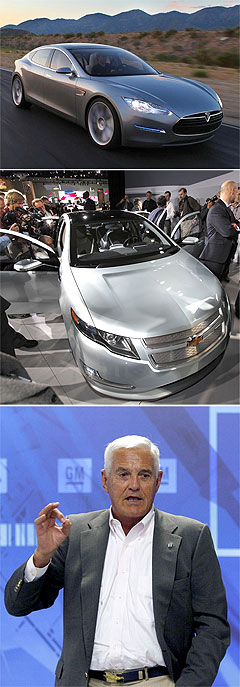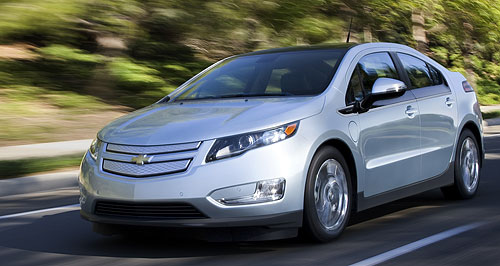Future models - Holden - VoltGM doffs cap to TeslaNew life: Lithium ion battery-equipped cars such as the Chevrolet Volt are set to write a new chapter for the car, says GM's Bob Lutz. Wounded Goliath thanks David as inspiration for the Volt against Doubting Thomases7 Dec 2009 By BYRON MATHIOUDAKIS in LOS ANGELES GENERAL Motors vice-chairman Bob Lutz has publically acknowledged electric car (EV) start-up company Tesla Motors as a key inspiration for the upcoming Volt range-extender electric vehicle (REV). In his speech as keynote speaker at the opening of the 2009 Los Angeles Auto Show, Mr Lutz revealed that it was Tesla’s core belief in the capabilities of the then-emerging lithium ion battery back in 2006 that helped persuade GM’s board to invest in the technology. “In 2006 I could think of only one company that openly was planning to build an electric vehicle powered by lithium ion batteries and that was Tesla,” Mr Lutz said. “I will tell you that they gave us the major impetus, and I am thankful to Tesla for furnishing us with the truth that was needed for us to champion the Volt to the corporation that other people believed in lithium ion technology as well. “And now of course just about every car company in the business is planning a lithium ion powered EV or E-REV vehicle, including some companies that weren’t even on the radar in 2006, like Fisker.”  Left: Tesla Model S, Chevrolet Volt and GM vice-chairman Bob Lutz. Left: Tesla Model S, Chevrolet Volt and GM vice-chairman Bob Lutz.That move towards the creation of the Volt, he said, was made in the wake of the 2006 documentary film Who Killed The Electric Car? – which documented GM’s reluctance to support its purely electric EV1 EV when it was released in the mid-1990s. “Some people still continue to think of GM as the company who – I quote – ‘killed the electric car’,” Mr Lutz said. “To the contrary, the electric car is far from dead at GM, and my friend Chris Paine who made the original ‘Who Killed …’ movie would be the first to tell you that. “We have massively expanded our commitment to the EV at GM … GM is moving from a company that for one hundred years has been based on mechanically driven automobiles to one that will be focussed on electrically driven automobiles. And this is a big deal.” However, he hastily added that GM had gone much further still than Tesla by eliminating the ‘range anxiety’ issues that can plague drivers of purely electrically driven EVs, by adding the small combustion engine to takeover from (and help recharge) the Volt’s batteries once they run out of charge after the (conservatively) stated 60km range. But Mr Lutz lamented that communicating the fact that the Volt will not leave people stranded is proving more difficult than expected, even though GM has broken away from established protocol by publicly discussing the lithium ion battery cell’s developmental progress. Also in an attempt to allay the aforementioned technology concerns, GM recently announced partnerships with battery specialists LG Chem and Compact Power a research and development curriculum based at the University of Michigan that aims to advance the lithium ion battery while creating new scientists who will specialise in this field for the future and a factory dedicated to the production of the Volt’s battery cells. “The thing about the Volt – and the thing that people seem to be really slow to grasp no matter how many times we say it – is that it eliminates range anxiety and the fear that they have to hitch a ride to the nearest power station for a five-gallon can of electricity,” he said. “And three years ago, when we revealed the original Volt Concept, there were many competitors who regaled the media with stories as to why the lithium ion battery could not be built for automobiles.” Mr Lutz said countless hundreds of man years (in battery research and development) had resulted in a battery pack that deliversed the required power, range, safety and durability that consumers had a right to expect. He added that GM was investing continuously in electric motor and the other complex electronics research needed to keep the Volt evolving, and that was helping to create new jobs and nurture nascent industries. “The EV is helping to create a whole new industries – and eco system of battery developers and recyclers, builders of home and commercial charging stations, power and electric control motor suppliers, which will create new jobs. “And as demand for electric vehicles grows, competition will drive further innovation, the eco system will continue to diversify, costs will decline, and vehicles sales will climb … so there are huge opportunities as well.” Mr Lutz said that going into Chapter 11 bankruptcy in June helped the company to re-evaluate and re-energise its advanced propulsion strategy and drive it towards a dramatically greener future. “We’re doing that, with the introduction of the Volt next year will be a huge step in that direction,” he said. “I have no doubt that years from now we will look back at this period as a time of great progress, the tipping point that allowed the age of the electrically driven vehicle. “It will be every bit as momentous as the transition from horses to horsepower.”  Read more23rd of November 2009  GM confirms Volt dateGM to commence production of US versions of its vital Volt in less than 12 months25th of August 2009  First look: Tesla's Model S and Roadster Sport on trackUS electric sportscar maker shows new sedan in testing, unveils sportier roadster21st of August 2009  SA premier takes Holden hybrid case to DetroitRann urges GM CEO to build plug-in hybrid small car in Australia14th of August 2009  Holden expects 1.2L/100km city economy for VoltHolden’s plug-in hybrid to offer ultra-low city economy as GM proclaims 230mpg Volt11th of August 2009  Commodore hybrid out of the VoltHolden VE hybrid hopes alive after GM announces plug-in V6 for new Buick SUV7th of July 2009  Tesla to produce a right-hook electric RoadsterTesla Motors takes EV aim at right-hand drive markets, including Australia15th of June 2009  Electric Cruze a Volt out of the blueGM boss rolls out plug-in Cruze at new US battery lab opening6th of April 2009  Tesla’s electric family car attracts massive interestTesla Motors takes 520 Model S reservations – at $US40,000 each – in first week |
Click to shareHolden modelsResearch Holden Motor industry news |
















Facebook Twitter Instagram